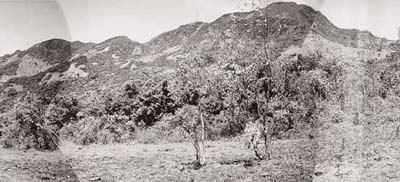 |
 21st June 1998 |
Front Page| |
Those peaks of grandeurBy Prof. P. G. Cooray
As we looked south from the Patana, we could see in the centre of the panoramic view the awesome peaks of Gombaniya (1906m), the highest peak in the massif, and Yakungegala, its companion, with their east-facing vertical, craggy, rocky escarpments. Immediately to their left is the flattish peak of Selvakanda (1617 m) dominating the Selvakanda Plateau, where can be found 100 acres of a unique pygmy forest and a growth of niloo, and to the west of that are the five peaks of the Knuckles (1864m). Further to the west and in the middle distance is Kalupahana peak, (1629 m) a striking, isolated mountain, rising from the flattish, Wamarapugala range, and still more in the foreground is the Lahumanagala-Rambukkolowa range, broken only by the Malkirigoda Gap. To the right of Gombaniya is the northern extension of the main Knuckles range, the Ratmatiya-Patanagala range, broken by the Bata Anduwa Gap. One could stand for hours drinking in the majesty of the scenery before one, in a spirit of amazement, wondering how this beautiful scenery came into being. And your wonder would be greatly increased if you knew that the rocks making these peaks and crags were at least 2 million years old!! During that time they were buried 20 to 30 km below the surface, compressed into folds, deformed and disrupted by faults, and eroded by sun, water and wind into their present forms. And this knowledge would make you realise how tremendous is the power of Nature. The uniqueness of the Knuckles region lies not only in its scenery and landforms, but also in the fact that growing and living in it are a large number of plants, birds and other animals that are endemic to Sri Lanka, and some even endemic to the Knuckles region. One of these, we even saw. It was the 'marbled cliff frog' (Nannophrys marmorata), a very flat frog, that has adapted itself to living in narrow spaces below rock boulders and rock ledges in scattered pools on the Patana. This is truly a fine example of adaptation to the environment. The Knuckles region is home to over 100 bird species, and of the 21 bird species endemic to Sri Lanka, 14 live in the Knuckles; it is also a refuge for numerous migratory birds. The pristine beauty of the entire scene before us was marred by a single eyesore - a stone building on the bare grassy slope down which the road from Rattota descends. It seems that a Colombo Company had tried to put up a hotel here, but that was thankfully stopped. The Knuckles region is a protected area, and nothing - and no one - should be allowed to spoil its beauty or destroy its unique character! It is to be hoped that all governments of this country, whatever their shade and colour, will never allow the grandeur of the Knuckles Massif to be spoilt by man, and that they will preserve its pristine beauty and its uniqueness for our children and for our children's children for generations to come. Prof. P.G. Cooray is the author of "The Knuckles Massif - A Portfolio" which is shortly to be published by the Forest Department. |
||
 |
More Plus * Working together to save children * Where will they go from here?
Front Page| News/Comment| Editorial/Opinion| Business| Sports | Mirror Magazine |
|
 |
Please send your comments and suggestions on this web site to |
|
 I
was standing on the Pitawala Patana, at the northern end of the
Knuckles Massif, on the morning of Saturday, June 7, with a party of over
200 senior students, teachers and other interested persons from the Matale
area and beyond, and once again, as always, I was struck by the beauty
and grandeur of the scene before me. We were all there to observe World
Environment Day, 1998, — and what better way to observe this important
day than to stand in the middle of an important part of our own environment?
I
was standing on the Pitawala Patana, at the northern end of the
Knuckles Massif, on the morning of Saturday, June 7, with a party of over
200 senior students, teachers and other interested persons from the Matale
area and beyond, and once again, as always, I was struck by the beauty
and grandeur of the scene before me. We were all there to observe World
Environment Day, 1998, — and what better way to observe this important
day than to stand in the middle of an important part of our own environment?